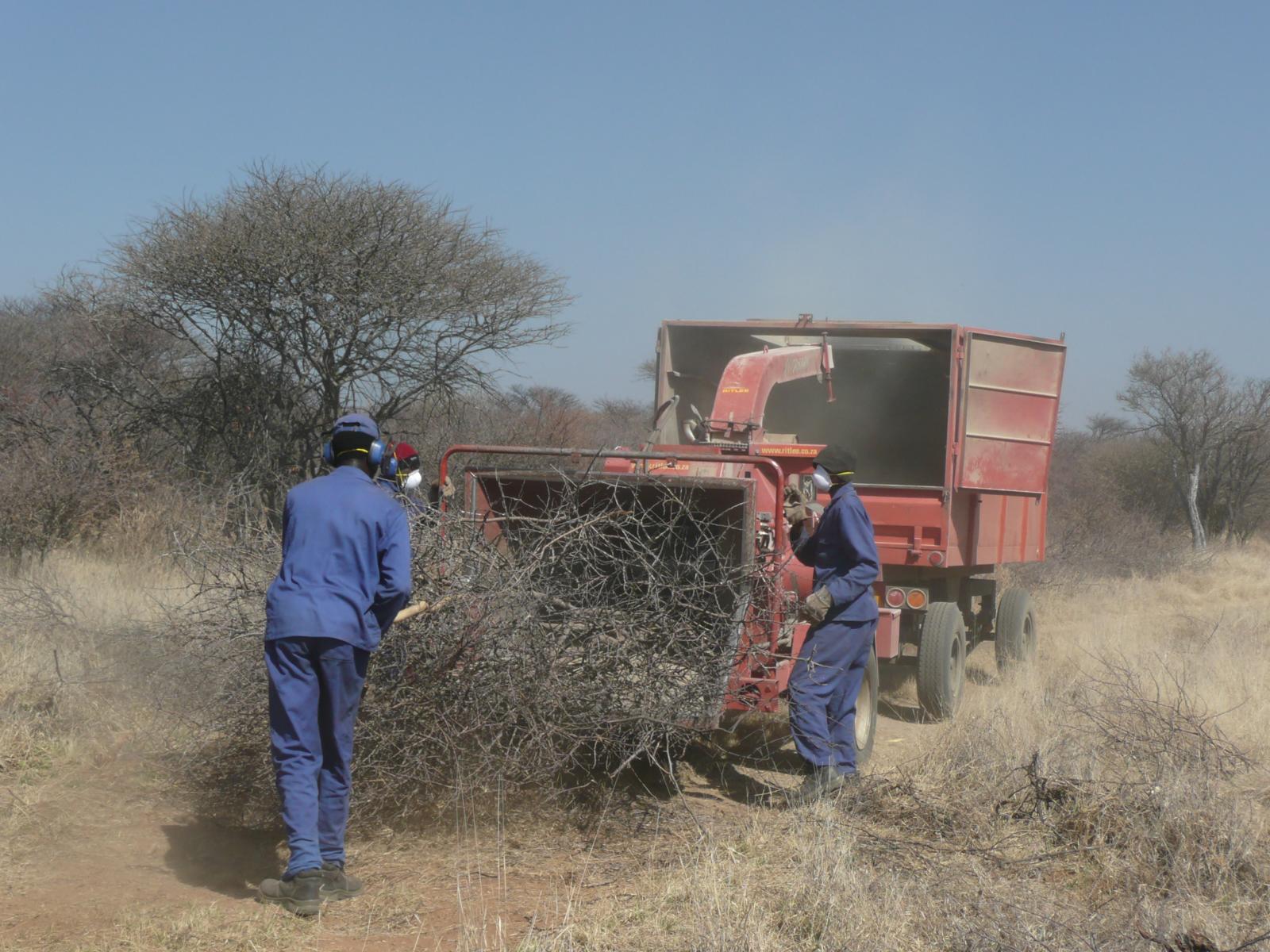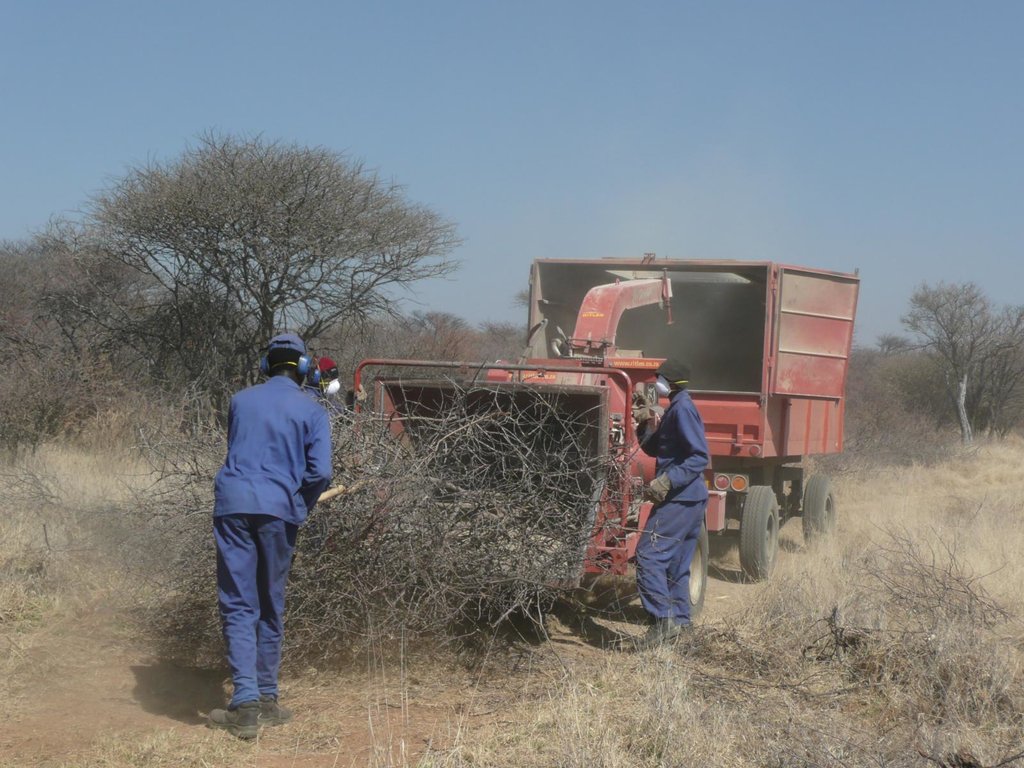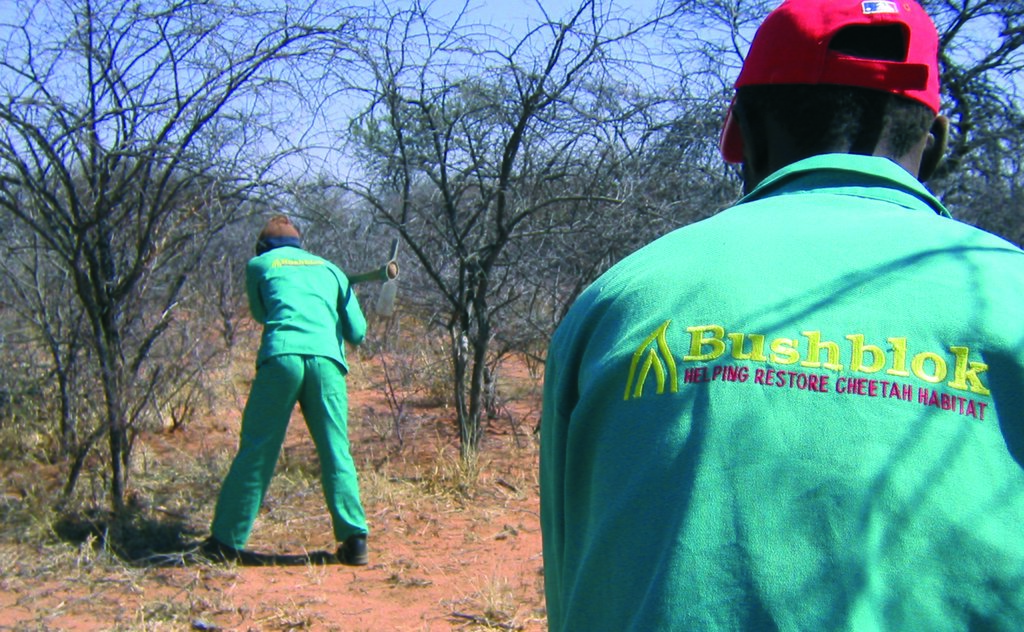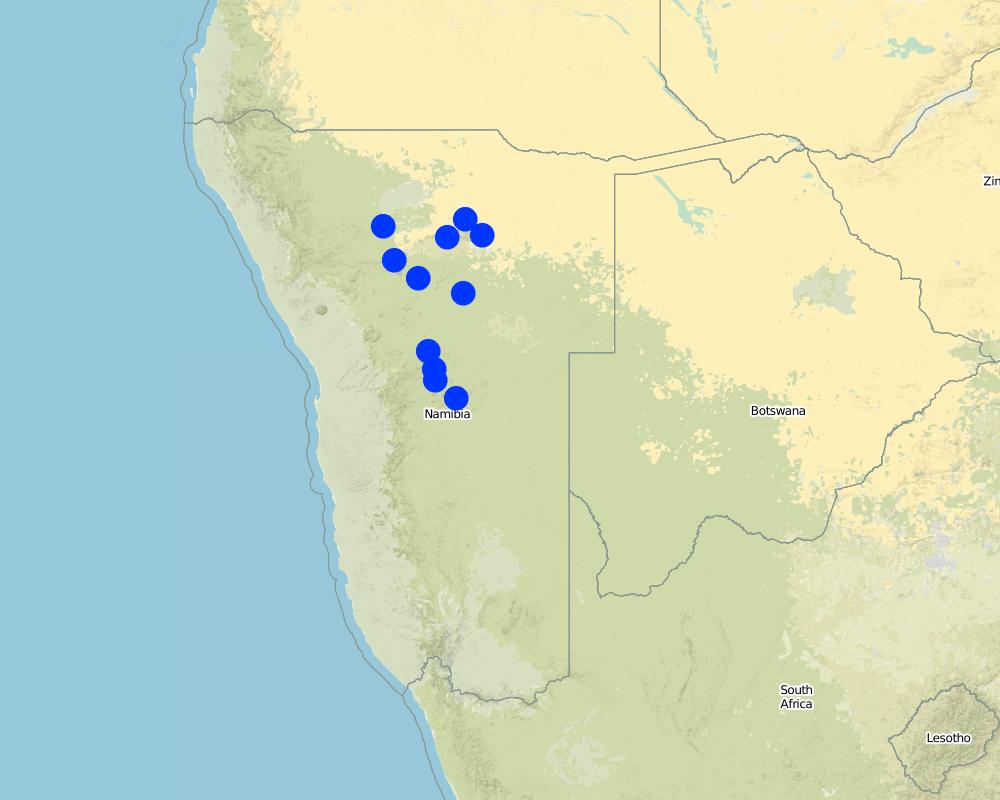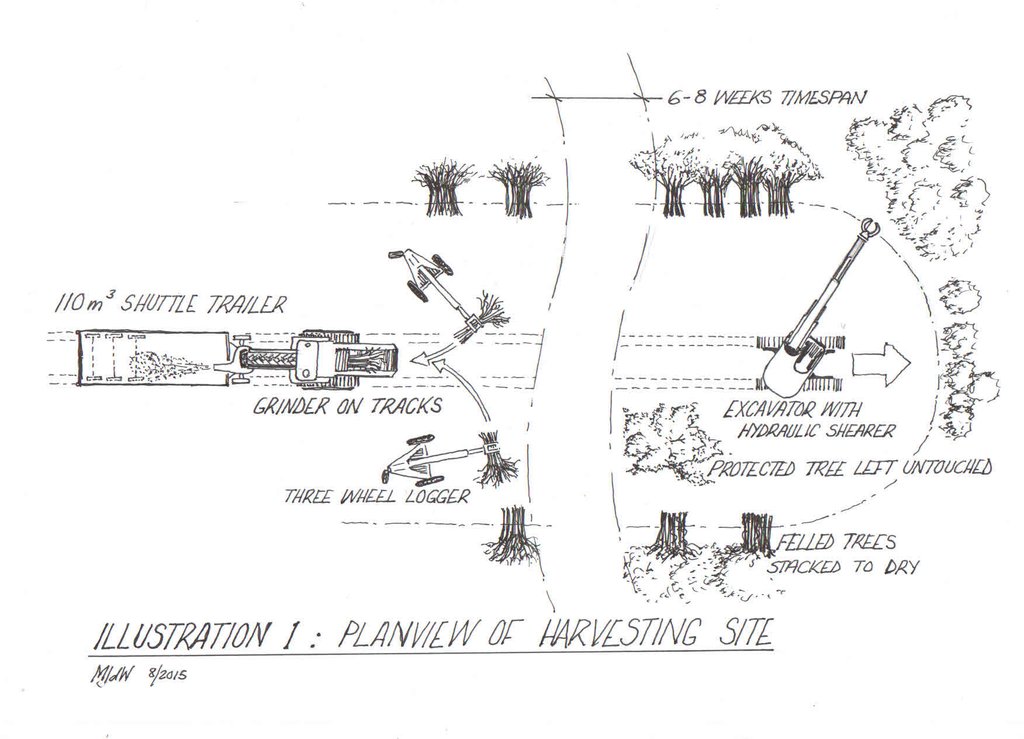Bush Thinning and Biomass Processing by Manual or Mechanised Means [Namibie]
- Création :
- Mise à jour :
- Compilateur : Johannes Laufs
- Rédacteur : Asellah David
- Examinateur : Rima Mekdaschi Studer
Bush Thinning
technologies_2203 - Namibie
- Résumé complet en PDF
- Résumé complet en PDF pour impression
- Résumé complet dans le navigateur
- Résumé complet (non formaté)
- L'éclaircissage de broussailles et le traitement de biomasse de façon manuelle ou mécanisée: 17 juillet 2018 (inactive)
- L'éclaircissage de broussailles et le traitement de biomasse de façon manuelle ou mécanisée: 31 mai 2019 (inactive)
- Bush Thinning and Biomass Processing by Manual or Mechanised Means: 22 août 2017 (inactive)
- L'éclaircissage de broussailles et le traitement de biomasse de façon manuelle ou mécanisée: 2 novembre 2021 (public)
- Bush Thinning and Biomass Processing by Manual or Mechanised Means: 21 février 2018 (inactive)
Voir les sections
Développer tout Réduire tout1. Informations générales
1.2 Coordonnées des personnes-ressources et des institutions impliquées dans l'évaluation et la documentation de la Technologie
Spécialiste GDT:
Gschwender Frank
frank.gschwender@giz.de
Nom du projet qui a facilité la documentation/ l'évaluation de la Technologie (si pertinent)
GIZ Support to De-bushing ProjectNom du ou des institutions qui ont facilité la documentation/ l'évaluation de la Technologie (si pertinent)
Deutsche Gesellschaft für Internationale Zusammenarbeit (GIZ)1.3 Conditions relatives à l'utilisation par WOCAT des données documentées
Quand les données ont-elles été compilées (sur le terrain)?
01/08/2014
Le compilateur et la(les) personne(s) ressource(s) acceptent les conditions relatives à l'utilisation par WOCAT des données documentées:
Oui
1.4 Déclaration sur la durabilité de la Technologie décrite
Est-ce que la Technologie décrite ici pose problème par rapport à la dégradation des terres, de telle sorte qu'elle ne peut pas être déclarée comme étant une technologie de gestion durable des terres?
Non
Commentaires:
The technology described is a means to rehabilitate degraded rangeland. Through targeted harvesting of bushes, the bush density is reduced, allowing for better growth of grass.
1.5 Référence au(x) questionnaire(s) sur les Approches de GDT
2. Description de la Technologie de GDT
2.1 Courte description de la Technologie
Définition de la Technologie:
In Namibia, excess bush is harvested to reduce competition with other plants, especially grasses. Bush can be thinned manually (e.g. with axes), semi-mechanised (e.g. chainsaws) or fully mechanised (e.g. customised equipment). After cutting, the bush is left to dry and then processed into chips or other products.
2.2 Description détaillée de la Technologie
Description:
Bush thinning is carried out in Namibia to restore degraded rangeland by stimulating the re-growth of grasses – which are suppressed by excess bush. About 30-45 million hectares are affected by bush encroachment, and this affects biodiversity, groundwater recharge and the carrying capacity of rangeland. There are many causes of bush encroachment, including overgrazing and reduced frequency of wildfires. Most bush encroachment involves indigenous, rather than invasive, species.
While natural transitions in the ecosystems may lead to reductions in bush encroachment, active rehabilitation measures are required for the short-term improvements. This is an absolute necessity for many farmers, who experience severe economic difficulties due to the reduced productivity of their rangeland.
Bush control comprises responsive measures (bush thinning), follow-up measures (aftercare) as well as preventative measures (good rangeland management). Since vast areas of Namibian rangeland are heavily encroached by bush, the focus is currently on bush thinning. This entails selective harvesting of bush. To determine the density of bush remaining after thinning, a formula based on tree equivalent (TE) and average annual rainfall is used. One TE is defined as a woody tree or bush of 1.5 metres in height.
As rule of thumb for attaining optimal bush density, about 30-35% of encroacher biomass should be removed. This is based on research carried out mainly in South Africa, measuring and comparing the re-growth after bush removal. Where too much bush was removed, this often resulted in even heavier encroachment.
Bush thinning follows strict environmental guidelines set by the Directorate of Forestry (DoF) through the Forestry Act and the Directorate of Environmental Affairs (DEA) through the Environmental Management Act. This governs the equipment used (to avoid soil disturbance) and the amount of bushes harvested (to achieve a healthy number of the desired bush species). The amount of bushes to be harvested is determined by an expert and depends on various factors.
While there is a lack of precise knowledge on the long-term effect of bush thinning, there is no doubt that control has an overall positive effect on the savannah ecosystem in Namibia. The need is widely recognised among land owners and acknowledged on the national political agenda.
To render bush thinning economically feasible, value chains have been developed. Through processing and utilisation of the woody biomass, income can be generated. Processed bush biomass can, for example in the form of chips, can be used for thermal and electrical energy applications (e.g. local biomass power plants or biomass boilers for industry). Currently two such energy installations exist in Namibia, one at a local brewery and one at a local cement factory. In addition, the national power utility NamPower currently considers the construction of a 20-40 MW biomass power plant.
Other existing value chains include the production of charcoal, firewood, poles, as well as bush -based animal feed. Further value chains under consideration include composite materials, such as wood-plastic, as well as biochar.
Scientific observations have shown, that bush thinning requires regular follow-up. These measures (“aftercare”) include the prevention of coppicing and re-growth. This can be achieved by applying aboricides selectively to the cut stems, stem fires or the introduction of browsers (e.g. goats). Research on the effectiveness and possible side effects of each of these methods is limited.
A major challenge is the limited suitability of available machines. The process leads to high wear and tear on the equipment (both harvesting and processing technology, (like chippers and pelletisers), often rendering operations unprofitable. Research into, and development of, more suitable machinery is necessary. Other requirements are improved skills training and continuous monitoring of the long-term effects on rangeland.
2.3 Photos de la Technologie
Remarques générales concernant les photos:
All photos have either been taken by the GIZ Support to De-bushing Project or were provided to the project by third parties.
2.4 Vidéos de la Technologie
Commentaire, brève description:
https://www.youtube.com/watch?v=859GshR9hso&t=3s
Bush Encroachment in Namibia: Causes and Extent
An explanation of the root causes of bush encroachment and its impact on land in Namibia.
Date:
01/11/2015
Lieu:
Namibia
Nom du vidéaste:
GIZ Support to De-bushing Project
Commentaire, brève description:
https://www.youtube.com/watch?v=bmlzPDiqlxo&t=45s
Biomass Value Addition: Bush Based Products
An overview of existing and potential value chains based on encroacher bush.
Date:
01/11/2015
Lieu:
Namibia
Nom du vidéaste:
GIZ Support to De-bushing Project
Commentaire, brève description:
https://www.youtube.com/watch?v=MMSOfV2KBjA
Biomass Energy: From Bush to Electricity
Overview of the energetic applications of woody biomass from encroacher bush.
Date:
01/11/2015
Lieu:
Namibia
Nom du vidéaste:
GIZ Support to De-bushing Project
2.5 Pays/ région/ lieux où la Technologie a été appliquée et qui sont couverts par cette évaluation
Pays:
Namibie
Autres spécifications du lieu:
Bush control is applied across Namibia on many privately owned farms. Activities are most concentrated in the regions Khomas, Omaheke, Otjozondjupa and Oshikoto.
Commentaires:
Pointers on the map only indicate points (e.g. urban centres) around which activities are concentrated. It is not possible to depict each site where bush control is implemented due to the high number of individual activities and projects.
Map
×2.6 Date de mise en œuvre de la Technologie
Indiquez l'année de mise en œuvre:
2015
2.7 Introduction de la Technologie
Spécifiez comment la Technologie a été introduite: :
- grâce à l'innovation d'exploitants des terres
- au cours d'expérimentations / de recherches
- par le biais de projets/ d'interventions extérieures
Commentaires (type de projet, etc.) :
Since the 1950s the phenomenon of bush encroachment has been recognised by farmers in Namibia and counter measures have been implemented over the decades. The technologies applied largely relied on the means and innovative capabilities of the respective land owner. Only as of 2014, through the introduciton of a national Support to De-bushing Project, are technologies systematically researched and tested in the field.
3. Classification de la Technologie de GDT
3.1 Principal(aux) objectif(s) de la Technologie
- améliorer la production
- réduire, prévenir, restaurer les terres dégradées
- préserver l'écosystème
- conserver/ améliorer la biodiversité
- créer un impact économique positif
3.2 Type(s) actuel(s) d'utilisation des terres, là où la Technologie est appliquée

Pâturages
Pâturage extensif:
- Ranching
Principales espèces animales et principaux produits:
Cattle, goats, game
Commentaires:
Namibia is characterised by large commercial cattle farms. Du to its aridity the land is largely unsuitable for crop farming, with exceptions in high-rainfall areas such as the Grootfontein, Tsumeb, Otavi triangle.
The Northern parts of Namibia are managed as communal land, where farmers have lease holds for their land. In these areas a combination of millet production and cattle herding is common.
Si l'utilisation des terres a changé en raison de la mise en œuvre de la Technologie, indiquez l'utilisation des terres avant la mise en œuvre de la Technologie:
The implementation of bush thinning allows to maintain the land use (e.g. cattle ranching) and is typically applied to increase productivity in the long-term.
3.3 Informations complémentaires sur l'utilisation des terres
Approvisionnement en eau des terres sur lesquelles est appliquée la Technologie:
- pluvial
Nombre de période de croissance par an: :
- 1
Densité d'élevage/ chargement (si pertinent):
284 000 in targeted area (105460km2) of bush thinning (Otjozondjupa region).
3.4 Groupe de GDT auquel appartient la Technologie
- pastoralisme et gestion des pâturages
- Amélioration de la couverture végétale/ du sol
3.5 Diffusion de la Technologie
Spécifiez la diffusion de la Technologie:
- répartie uniformément sur une zone
Si la Technologie est uniformément répartie sur une zone, indiquez la superficie couverte approximative:
- 1 000-10 000 km2
Commentaires:
Currently bush thinning is implemented on a total of approximately 120.000 hectares (1.200 km2) of farmland per annum. These activities are not confied to certain areas, but spread across all of Namibia, typically concentrating in the most encroached areas (e.g. Otjozondjupa, Khomas, Oshikoto and Omaheke regions).
3.6 Mesures de GDT constituant la Technologie

pratiques végétales
- V4: Remplacement ou suppression des espèces étrangères envahissantes

modes de gestion
- M2: Changement du niveau de gestion / d'intensification
- M5: Contrôle/ changement de la composition des espèces
3.7 Principaux types de dégradation des terres traités par la Technologie

dégradation biologique
- Bh: perte d’habitats
- Bq: baisse de la quantité/ biomasse
- Bs: baisse de la qualité et de la composition/ diversité des espèces
3.8 Prévention, réduction de la dégradation ou réhabilitation des terres dégradées
Spécifiez l'objectif de la Technologie au regard de la dégradation des terres:
- prévenir la dégradation des terres
- restaurer/ réhabiliter des terres sévèrement dégradées
4. Spécifications techniques, activités, intrants et coûts de mise en œuvre
4.1 Dessin technique de la Technologie
4.2 Spécification/ explications techniques du dessin technique
Drawing of a bush harvesting site layout. The drawing depicts fully mechanised bush harvesting and immediate processing into wood chips. This set-up is most suitable for large-scale bush thinning, e.g. for the purpose of supplying biomass in larger quantities. Such off-take includes the potential export of bush in processed form (pellets) or energetic utilisation (e.g. local biomass power plants or biomass boilers in the industry). Currently two such energy solutions exist in Namibia, one at a local brewery and one at a local cement factory.
Note that a range of bush harvesting methods exist, ranging from fully mechanised (as depicted) to manual bush harvesting (e.g. with axes). The site layout and principles are the same in all scenarios, but harvesting speed and costs differ.
The bush harvesting process:
Bushes are harvested selectively with and excavator, to which a hydraulic sheer cutter is attached. The biomass is stacked in rows and left for drying some six to eight weeks (depending on weather conditions). The biomass is then further processed with a chipper and collected with a trailer for further transport off the farm (e.g. to a biomass power plant or industrial off-taker). As a rule of thumb, one third of the standing biomass is removed, leaving two thirds standing. Harvesting starts with smaller plants and then moves to larger ones, cutting only plants with 15 centimetres of diameter or less (as per Namibian forestry regulations).
4.3 Informations générales sur le calcul des intrants et des coûts
Spécifiez la manière dont les coûts et les intrants ont été calculés:
- par superficie de la Technologie
Indiquez la taille et l'unité de surface:
1 hectare
autre/ monnaie nationale (précisez):
Namibia Dollar (NAD)
Indiquer le taux de change du dollars en monnaie locale (si pertinent): 1 USD= :
0,078
Indiquez le coût salarial moyen de la main d'œuvre par jour:
Namibia Dollar (NAD) 110
4.4 Activités de mise en place/ d'établissement
| Activité | Type de mesures | Calendrier | |
|---|---|---|---|
| 1. | Bush harvesting/felling | Végétale | Year around |
| 2. | Stacking (and drying) | Autres mesures | Year around |
| 3. | Feeding the chipping operation | Autres mesures | Year around |
| 4. | Transport | Autres mesures | Year around |
Commentaires:
The restorative measure includes bush harvesting/felling as well as aftercare measures. Additional activities include the processing (e.g. into chips) and transport of the woody material off the farm/land.
4.5 Coûts et intrants nécessaires à la mise en place
| Spécifiez les intrants | Unité | Quantité | Coûts par unité | Coût total par intrant | % des coût supporté par les exploitants des terres | |
|---|---|---|---|---|---|---|
| Main d'œuvre | 1 x Mechanic | person days | 0,2 | 2000,0 | 400,0 | |
| Main d'œuvre | 4 x Operators | person days | 0,8 | 300,0 | 240,0 | |
| Main d'œuvre | 1 x Operation manager chipping | person days | 0,2 | 1000,0 | 200,0 | |
| Main d'œuvre | 1 x Chipping operator | person days | 2,0 | 150,0 | 300,0 | |
| Equipements | 1 x 12t Excavator | pieces | 1,0 | 120,0 | 120,0 | |
| Equipements | 2 x Hydraulic grab and shearing attachments | pieces | 2,0 | 60,0 | 120,0 | |
| Equipements | 2 x Three wheel loggers | pieces | 2,0 | 180,0 | 360,0 | |
| Equipements | 1 x Chipper | pieces | 1,0 | 840,0 | 840,0 | |
| Autre | Management and administration overhead | lump sum | 1,0 | 200,0 | 200,0 | |
| Autre | 12,0 | |||||
| Coût total de mise en place de la Technologie | 2780,0 | |||||
Commentaires:
Cost of bush harvesting can be calculated per hectare (e.g. land owner's perspective) or per tonne (in fuel supply agreements with off-takers). All given costs are approximations, as costs vary widely depending on the local framework conditions on a given piece of land. Typically the costs to harvest and process bush on one hectare range from 2,000 NAD to 4,000 NAD.
4.6 Activités d'entretien/ récurrentes
| Activité | Type de mesures | Calendrier/ fréquence | |
|---|---|---|---|
| 1. | Aftercare | Végétale | Annually |
Commentaires:
When land is thinned it creates a vacuum in which weeds and woody plants (sometimes more aggressive colonisers than the original encroacher species) will quickly establish themselves. Regular aftercare needs to be applied in order to prevent the excessive re-growth of bush (and therewith new degradation of the land). Various methods are in use to manage the re-growth of bush following harvesting. These include selective application of arboricides, stem burning, and intensive browsing by goats or antelopes.
The more sustainable the bush harvesting itself has taken place, importantly not completely clearing larger areas of vegetation, the less likely is agressive re-growth of bush. In all bush thinning exercises it is important to leave larger bushes and trees untouched and to start by removing the smaller, less established bushes. In addition, not only individual larger bushes must be left standing, but also islands/patches of bushes, which fulfill important ecosystem services, e.g. habitat for animals.
4.7 Coûts et intrants nécessaires aux activités d'entretien/ récurrentes (par an)
Si possible, ventilez le coût de l'entretien selon le tableau suivant: spécifiez les intrants et le coût par intrant. Si vous n'êtes pas en mesure de ventiler le coût, donnez une estimation du coût total de l'entretien de la Technologie:
500,0
Commentaires:
Commonly aftercare is applied in form of manual application of herbicides to the cut stems, in order to prevent re-growth of the bushes.
4.8 Facteurs les plus importants affectant les coûts
Décrivez les facteurs les plus importants affectant les coûts :
(1) Investment in machinery (if not applied manually).
(2) Maintenance of machinery (high wear and tear due to hardness of wood and high mineral content).
(3) Remoteness of farms/land from buyers/markets.
5. Environnement naturel et humain
5.1 Climat
Précipitations annuelles
- < 250 mm
- 251-500 mm
- 501-750 mm
- 751-1000 mm
- 1001-1500 mm
- 1501-2000 mm
- 2001-3000 mm
- 3001-4000 mm
- > 4000 mm
Spécifiez la pluviométrie moyenne annuelle (si connue), en mm:
350,00
Spécifications/ commentaires sur les précipitations:
Namibia is a semi-arid country and rainfall ranges roughly from 150-550 mm per year (rough approximation due to the vastness of the area described).
Indiquez le nom de la station météorologique de référence considérée:
Various
Zone agro-climatique
- semi-aride
5.2 Topographie
Pentes moyennes:
- plat (0-2 %)
- faible (3-5%)
- modéré (6-10%)
- onduleux (11-15%)
- vallonné (16-30%)
- raide (31-60%)
- très raide (>60%)
Reliefs:
- plateaux/ plaines
- crêtes
- flancs/ pentes de montagne
- flancs/ pentes de colline
- piémonts/ glacis (bas de pente)
- fonds de vallée/bas-fonds
Zones altitudinales:
- 0-100 m
- 101-500 m
- 501-1000 m
- 1001-1500 m
- 1501-2000 m
- 2001-2500 m
- 2501-3000 m
- 3001-4000 m
- > 4000 m
Indiquez si la Technologie est spécifiquement appliquée dans des:
- non pertinent
5.3 Sols
Profondeur moyenne du sol:
- très superficiel (0-20 cm)
- superficiel (21-50 cm)
- modérément profond (51-80 cm)
- profond (81-120 cm)
- très profond (>120 cm)
Texture du sol (de la couche arable):
- grossier/ léger (sablonneux)
Texture du sol (> 20 cm sous la surface):
- grossier/ léger (sablonneux)
Matière organique de la couche arable:
- faible (<1%)
5.4 Disponibilité et qualité de l'eau
Profondeur estimée de l’eau dans le sol:
5-50 m
Disponibilité de l’eau de surface:
faible/ absente
Qualité de l’eau (non traitée):
eau potable
La salinité de l'eau est-elle un problème? :
Non
La zone est-elle inondée?
Non
5.5 Biodiversité
Diversité des espèces:
- faible
Diversité des habitats:
- moyenne
5.6 Caractéristiques des exploitants des terres appliquant la Technologie
Sédentaire ou nomade:
- Sédentaire
Orientation du système de production:
- commercial/ de marché
Revenus hors exploitation:
- moins de 10% de tous les revenus
Niveau relatif de richesse:
- moyen
Individus ou groupes:
- individu/ ménage
Niveau de mécanisation:
- mécanisé/ motorisé
Genre:
- femmes
- hommes
Age des exploitants des terres:
- personnes d'âge moyen
5.7 Superficie moyenne des terres détenues ou louées par les exploitants appliquant la Technologie
- < 0,5 ha
- 0,5-1 ha
- 1-2 ha
- 2-5 ha
- 5-15 ha
- 15-50 ha
- 50-100 ha
- 100-500 ha
- 500-1 000 ha
- 1 000-10 000 ha
- > 10 000 ha
Cette superficie est-elle considérée comme de petite, moyenne ou grande dimension (en se référant au contexte local)?
- grande dimension
Commentaires:
Typical commercial farm size is 5.000 ha. The size increases with decreasing rainfall (towards southern Namibia).
5.8 Propriété foncière, droits d’utilisation des terres et de l'eau
Propriété foncière:
- individu, avec titre de propriété
Droits d’utilisation des terres:
- individuel
Droits d’utilisation de l’eau:
- individuel
5.9 Accès aux services et aux infrastructures
santé:
- pauvre
- modéré
- bonne
éducation:
- pauvre
- modéré
- bonne
assistance technique:
- pauvre
- modéré
- bonne
emploi (par ex. hors exploitation):
- pauvre
- modéré
- bonne
marchés:
- pauvre
- modéré
- bonne
énergie:
- pauvre
- modéré
- bonne
routes et transports:
- pauvre
- modéré
- bonne
eau potable et assainissement:
- pauvre
- modéré
- bonne
services financiers:
- pauvre
- modéré
- bonne
6. Impacts et conclusions
6.1 Impacts sur site que la Technologie a montrés
Impacts socio-économiques
Production
production fourragère
Commentaires/ spécifiez:
Bush-based animal feed production has been successfully trialed and is implemented by various farmers across Namibia.
production animale
Commentaires/ spécifiez:
Carrying capacity of bush controlled land increases if regular aftercare is implemented.
production d'énergie
Commentaires/ spécifiez:
Bush-to-electricity value chain under development. Several industrial off-takers use woody biomass for boilers (heat), the national power utility currently develops a first biomass power plant.
Disponibilité et qualité de l'eau
disponibilité de l'eau pour l'élevage
Commentaires/ spécifiez:
Studies show a direct positive correlation between the extent of bush control and the availability of groundwater.
Revenus et coûts
revenus agricoles
Commentaires/ spécifiez:
Bush based value addition, e.g. charcoal production, leads to additional income for land owners and farm workers.
diversité des sources de revenus
Commentaires/ spécifiez:
Bush based value addition, e.g. charcoal production, leads to additional income for land owners and farm workers.
Impacts écologiques
Biodiversité: végétale, animale
biomasse/ au dessus du sol C
diversité végétale
espèces étrangères envahissantes
Commentaires/ spécifiez:
Alien species are completely removed where possible (e.g. Prosopis).
6.3 Exposition et sensibilité de la Technologie aux changements progressifs et aux évènements extrêmes/catastrophes liés au climat (telles que perçues par les exploitants des terres)
Changements climatiques progressifs
Changements climatiques progressifs
| Saison | Type de changements/ extrêmes climatiques | Comment la Technologie fait-elle face à cela? | |
|---|---|---|---|
| précipitations annuelles | décroît | pas bien |
Extrêmes climatiques (catastrophes)
Catastrophes climatiques
| Comment la Technologie fait-elle face à cela? | |
|---|---|
| sécheresse | pas bien du tout |
Commentaires:
Despite only limited research exists, long periods of drought that the country has recently faced, are credited to climate change. Drought intensifies the challenge for farmers, as already degraded rangeland has limited capacity to recover in the absence of rain. The technology of bush thinning itself has limited effect if no rain follows the removal of bushes.
6.4 Analyse coûts-bénéfices
Quels sont les bénéfices comparativement aux coûts de mise en place (du point de vue des exploitants des terres)?
Rentabilité à court terme:
négative
Rentabilité à long terme:
très positive
Quels sont les bénéfices comparativement aux coûts d'entretien récurrents (du point de vue des exploitants des terres)?
Rentabilité à court terme:
négative
Rentabilité à long terme:
très positive
Commentaires:
Bush thinned land takes 3-5 years to fully recover its productive grass layer, thus direct economic benefits are only experienced with a delay.
6.5 Adoption de la Technologie
- cas isolés/ expérimentaux
Si disponible, quantifiez (nombre de ménages et/ou superficie couverte):
120'000 hectares are bush thinned per year in Namibia; figures on the increase
Parmi tous ceux qui ont adopté la Technologie, combien d'entre eux l'ont fait spontanément, à savoir sans recevoir aucune incitation matérielle ou aucun paiement?
- 50-90%
Commentaires:
Farmers largely implement bush control on their own initiative; increasingly value chains are being developed and dedicated service providers offer bush control.
6.6 Adaptation
La Technologie a-t-elle été récemment modifiée pour s'adapter à l'évolution des conditions?
Oui
Si oui, indiquez à quel changement la Technologie s'est adaptée:
- évolution des marchés
Spécifiez l'adaptation de la Technologie (conception, matériaux/ espèces, etc.):
Increasingly bush harvesting is carried out with mechanised means, aiming at large scale production for large biomass off-takers, both in the country and internationally.
6.7 Points forts/ avantages/ possibilités de la Technologie
| Points forts/ avantages/ possibilités du point de vue de l'exploitant des terres |
|---|
| Effective measure against bush encroachment |
| Costs can be balanced with additional income through the sale of the biomass/biomass based products |
| Points forts/ avantages/ possibilités du point de vue du compilateur ou d'une autre personne ressource clé |
|---|
| Apart from the main purpose of rehabilitating rangeland, bush control has various side benefits, such as employment creation and industrialisation. |
| Bush control and biomass utilisation can contribute to energy security in the country. |
| The available range of technologies (from manual to fully mechanised) allows to develop viable concept for all types of land/land ownership scenarios. |
6.8 Faiblesses/ inconvénients/ risques de la Technologie et moyens de les surmonter
| Faiblesses/ inconvénients/ risques du point de vue de l’exploitant des terres | Comment peuvent-ils être surmontés? |
|---|---|
| High initial costs involved. | Development of dedicated financial products. |
| Possible negative consequences, such as more aggressive re-growth of species. | Increased knowledge dissemination, skills development and mentorship programmes. |
| Faiblesses/ inconvénients/ risques du point de vue du compilateur ou d'une autre personne ressource clé | Comment peuvent-ils être surmontés? |
|---|---|
| Necessity of cross-sector collaboration, e.g. agriculture, forestry, environment, industry, energy and resulting complexity. | Introduction of effective steering body on national level. |
| Challenges to sustain operations in communal areas/on land that is not owned by individuals. | Development of concepts for community based projects and cooperation with relevant regional authorities and decision making bodies (e.g. Regional Councils, Conservancies). |
7. Références et liens
7.1 Méthodes/ sources d'information
- visites de terrain, enquêtes sur le terrain
De-bushing Advisory Service Demand Survey (2015), 361 respondents
- compilation à partir de rapports et d'autres documents existants
Various
7.2 Références des publications disponibles
Titre, auteur, année, ISBN:
Baseline Assessment for De-bushing Programme in Namibia (2014)
Disponible à partir d'où? Coût?
GIZ Support to De-bushing Project, www.dasnamibia.org/downloads
Titre, auteur, année, ISBN:
Demand Survey for the implementation of a De-bushing Advisory Service (2015)
Disponible à partir d'où? Coût?
GIZ Support to De-bushing Project, www.dasnamibia.org/downloads
Titre, auteur, année, ISBN:
Value Added user-opportunities for encroacher bush (2015)
Disponible à partir d'où? Coût?
GIZ Support to De-bushing Project, www.dasnamibia.org/downloads
Titre, auteur, année, ISBN:
Compendium of harvesting technologies for encroacher bush (2015)
Disponible à partir d'où? Coût?
GIZ Support to De-bushing Project, www.dasnamibia.org/downloads
Titre, auteur, année, ISBN:
Assessment of biomass resource and potential yield in Namibia (2015)
Disponible à partir d'où? Coût?
GIZ Support to De-bushing Project, www.dasnamibia.org/downloads
Titre, auteur, année, ISBN:
Strategic Environmental Assessment (SEA) on bush thinning and biomass utilisation (2015)
Disponible à partir d'où? Coût?
GIZ Support to De-bushing Project, www.dasnamibia.org/downloads
Titre, auteur, année, ISBN:
Assesment of financial products and incentive schemes for bush harvesting and value addition (2015)
Disponible à partir d'où? Coût?
GIZ Support to De-bushing Project, www.dasnamibia.org/downloads
Titre, auteur, année, ISBN:
Environmental and forestry bush harvesting guidelines and generic Environmental Management Plan (2016)
Disponible à partir d'où? Coût?
GIZ Support to De-bushing Project, www.dasnamibia.org/downloads
Titre, auteur, année, ISBN:
Regional assessment of the economics of land degradation related to bush encroachment in Otjozondjupa, Namibia
Disponible à partir d'où? Coût?
GIZ Support to De-bushing Project, www.dasnamibia.org/downloads
7.3 Liens vers les informations pertinentes disponibles en ligne
Titre/ description:
De-bushing Advisory Service (DAS) Namibia, Resource Section
URL:
www.dasnamibia.org/downloads
Titre/ description:
Namibia Biomass Industry Group (N-BiG)
URL:
www.n-big.org
Titre/ description:
Videos
URL:
https://www.youtube.com/channel/UCwCICCfwf0SdVBqg2ZcAcKA
Titre/ description:
Namibia Charcoal Association (NCA)
URL:
www.ncanamibia.com
Liens et modules
Développer tout Réduire toutLiens
Aucun lien
Modules
Aucun module trouvé


